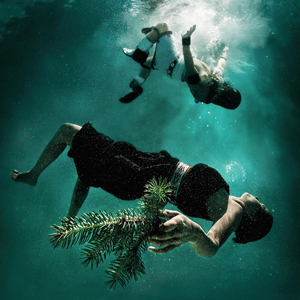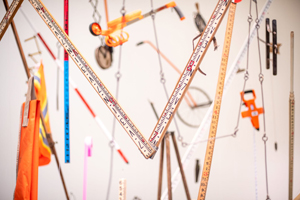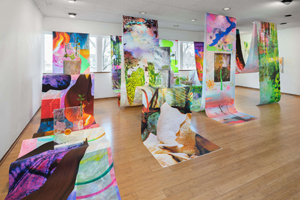Still Waters
John Haberin New York City
Water Memories and Native American Art
Carolina Caycedo, David de Rozas, and Water Scarcity
"Water Memories" opens with what the Met calls "ancestral connections." Like still waters, those memories and connections run deep.
And yet one can hardly help asking: just who is remembering? It may not be who you think. In fact, it takes more than a moment for Native Americans to appear at all, much less Native American lands. Carolina Caycedo and David de Rozas at MoMA take those lands as their starting point. Their installation gives visual and oral testimony to what tribes have lost and what they can still preserve. 
Can a thing of beauty be a global catastrophe? Either one might be a work of art. Wave Hill devotes its Glyndor Gallery to "Water Scarcity" and the plight of indigenous peoples. Flooding, air pollution, and wildfires may literally take your breath away, but here climate change is breathtaking. Political art can easily devolve into a lecture, but it made me aware of another risk entirely. As Tahir Carl Karmali puts it, "Beauty is a hard addiction to shake."
Drowning in memories
"Water Memories" introduces its themes with stylized waves by Arthur Dove, rising to the top of a painting. It may remind you of dangerous New England coastal waters in Winslow Homer and John Marin. It has to remind you all the more of Dove's drive toward abstraction. What it will not evoke is who once navigated those waters. Nearby, William Merritt Chase brings Impressionism to the gentility of beach-goers in the Hamptons. Right next to that, Fritz Scholder finds terrors in much the same beaches.
From his name alone, one might expect the terrors of German Expressionism, and he delivers on an impressive scale. The three sections of his massive triptych do and do not add up, unrelenting and jarring. A sunbather might be in danger of burning up or melting away, while the brushwork turns others into raw meat. Or so it seems, but Scholder belonged to the La Jolla Band of Luiseno Indians, and he painted not in the wake of World War I, but in 1989. He called this Possession on the Beach, suggesting spiritual or demonic possession. In context, though, he cannot help asking just who owns America and its waters.
It is a strange start all the same. The opening works risk overpowering its theme, with a reminder that European art had no shortage of seascapes and river views either, from J. M. W. Turner in Venice to Claude Monet along the Seine as well. White settlers were eager to map America's waters, too, and the show includes early cyanotypes by Henry P. Bosse. The opening also raises the question of whether western and Native American art can speak to one another. The show comes in a series of "responses" to the Met's Native American collection in its American wing—and past exhibitions have followed Jules Tavernier and Karl Bodmer from Europe to the American west. Will this show have as clear a vision of tribal cultures?
It turns quickly to just that. Other sections speak of "Water and Sky," "Forests and Streams," and "Oceanic Imaginations," themes that could equally apply to Dineo Seshee Bopape in South Africa, but it is more modest than it sounds. It draws on the collection for lamps, toys, moccasins, and ceramics. That may sound self-defeating, too, with little bearing on water memories. Yet the ceramics are of whales, and whale oil fueled the lamps. If western and Native American art really can sustain a dialogue, it may be because the first sees the lands as a place of leisure or a force of nature, the second as a way of life.
A more productive dialogue is between past and present. As with Scholder, the show's highlights are contemporary Native American art. As curated by Patricia Marroquin Norby (or Purépecha), it crosses America from Late Erie to the Ho-Chunk nation of the Midwest, the Standing Rock Sioux of the Dakotas, and the Pueblo in California. And its living artists keep recalling the past while messing things up. Sculpted whale teeth from Courtney M. Leonard could pass for independent creatures or Minimalism. Tom Jones has called past work Studies in Cultural Appropriation, and they should have you asking just who is messing with whom.
Truman Lowe suspends his feather canoe from the ceiling, as if it were navigating the waters of the Met. Ritual dancers for Cara Romero may not be so lucky, for she has submerged them underwater. Still, that implies a deep connection, and the blue of photo shines. Cannupa Hanska fears the loss of those waters not from private interests but from climate change, and she conceives her project as "water protectors." On video, the actors hide their faces behind what could be tablet computers, as if lost in their devices, but as a Mirror Shield. You may still wonder at the paucity of work or strained connections, but water scarcity is real, art is a mirror onto nature once again.
The land is us
We do not just have claims to the land, a voice explains: "the land has claims to us." Carolina Caycedo and David de Rozas name their installation for the land—"Somi S'ek." They do not, though, claim the land for their work, for it has far too many claimants as it is. They care more for laying out the claims, going back well before Europeans arrived in 1785 with their papers and privileges.  They want to know what colonialism and privatization have changed and what they cannot.
They want to know what colonialism and privatization have changed and what they cannot.
Juan Marcias, chair of the Carrizo/Comecrudo people in West Texas and northern Mexico, enters at a crucial moment in their baggy forty-five minute video, A Teaching of the Hands. From that point on, his voice starts to take over the narrative, as does the land itself. It is a harsh land, the place of the sun—which is not to preclude clouds and a terrible downpour. It is not a desert, for it has a thick cover of what will have to do as vegetation. It is, though, flat and otherwise devoid of life. It stretches out to distant hills, formidable in their breadth and the base for long, dramatic sunsets.
Before his entry, the people of the land had to speak for themselves, if only by their silence. The family in a vintage photograph poses in front of their home, while another family poses with their house in living color. Suffice it to say that the voices move easily among past, present, and future. A young priest stands in front his church and against the horizon. The video cuts to Native American art from centuries past—an orange figure in the cape of a shaman. The inherited images also include horses, in much the same style as cave painting in Africa and Europe, and of course human hands.
Hand prints, too, are a claim, if a desperate one, and the land has a harder and harder time asserting its claims as well. The video cuts to oil rigs and, in close-up, the production of oil. The face of a dam is at least as implacable as Donald J. Trump's pathetic border wall. Instruments take their measure of the land as well, as does a map that places it, ominously, between Devil's River and the Rio Grande. More vintage instruments hang from the ceiling in the installation's sole other component—apart from just four watercolors, from the 1930s, of additional indigenous paintings. Yardsticks, sextants, a plumb line, and a tripod spread out toward the top or, if you prefer, funnel down toward the floor, as Measuring the Immeasurable.
Off and on, a man defies the measurable with his hands. He colors cells in a grid with red pencil, with neither numbers nor indication of place. With his bushy white beard, he might be a tribal elder who has seen it all and concedes nothing. Still, Carolina Caycedo and David de Rozas approach what the work's "universes" less with anger than with fascination. The churning of oil or its fire has a nasty beauty. The hills are now home to observatories as well, seen first from a distance and later from within as they open to the sky.
Could it take modernity to bring out the truth and reverence in the chair's claim, that "the land is us"? The artists did their research at UT Austin to assess the claims, on commission for Ballroom Marfa, a contemporary art museum. (You may know Marfa, Texas, more for Minimalism and earthworks by Donald Judd and Walter de Maria.) Much throughout is a cliché, including the words with which I opened and found so moving. That does not, though, preclude their claim to truth. Marcias can still speak of an "ongoing genocide," because he and the work will admit no break with the past.
The scarcity of beauty
Tahir Carl Karmali transforms a sunlit room into Kenya, where desertification has turned an already nomadic people into refugees, and "a well without water is a grave." A visitor to the Bronx mirrors their experience by crossing the room. Two platforms of rusted steel have the color of damp but drying soil, bringing one face to face with silk hangings bearing traces of actual soil in a color close to blood. Since Jackson Pollock or Yves Klein, painting has left traces of the artist, and Karmali titles one Scraped Knee.  Corrugated steel partly covers the window on the opposite wall, though never blocking the sun. It could pass for blinds that predate the exhibition, only coarser and heavier, but it adapts siding for refugee camps.
Corrugated steel partly covers the window on the opposite wall, though never blocking the sun. It could pass for blinds that predate the exhibition, only coarser and heavier, but it adapts siding for refugee camps.
Sound art burbles up from beneath the rust, with a disturbing rhythm. It cannot, though, shatter the sensation of entering a distant landscape. While not strictly part of the group show, Heidi Norton in the Sun Porch project space builds still more on sunlight and silk. Layers of both descend to stacks on the floor. Stains and photographs cover them with butterflies, flowers, and Jesus. A reference to the "sociology of nature" hints that the planet could use a blessing. Other text fragments are a challenge to read or to overlook.
Where Norton sees growth and renewal, Cannupa Hanska Luger finds a greater beauty in the desert. Future Ancestral Technologies heads for New Mexico, where White Sands glows yellow at sunset and shines in the silvery light of day. Two actors, crossing the sands much as the visitor crosses the gallery for Karmali, bring their local color as well. They have the elaborate costumes and determination of indigenous "monster slayers," as the video moves from day into night and night into day. As they slip in and out of its three channels, they are at once mere humans and supernatural visions.
They are also mythmakers, and Luger subtitles one channel New Myth. Maybe the future under climate change is not so bleak after all. For Lucy + Jorge Orta, it is not all about global warming either. They pick up the search for clean water in the Antarctic, where they will need all the help they can get. They make art in extreme weather as one huge survival kit, with a life vest, a lifeboat, yellow ropes, and water bottles polychromed to last. They cover a tent with the flags of many nations, because this village has no room for boundaries.
Norton's work is already The Edges of Everything, and her text refers to the Umwelt, an almost mythic term for the environment. The remaining three add up to "Water Scarcity: Perpetual Thirst." So which is it, perpetual thirst or a hungering for art? Wave Hill might well the last place to run dry. It has its two-tiered lawns, its greenhouse gardens, and its views of the Hudson past sheltering trees. The trek from the subway passes through Riverdale and Fieldston, with their luxuriant private schools and private streets.
In the interest of full disclosure, I went to high school there, although those private houses are well outside a critic's price range. And summer group shows in the gardens make the most of their location and the season, with themes of art and science, feminism and land art, "This Place We Once Remembered," and "Flora Fantastica!" This one adds concerns for diversity and universality as well, with reference to native peoples on three continents. The curators refer to scarcity but also sustainability—and to the "fragility and resilience of the human condition." Still, political correctness may well be warranted as a key to survival. So, in those white sands, may be beauty.

"Water Memories" ran at The Metropolitan Museum of Art through April 2, 2023, Carolina Caycedo and David de Rozas at The Museum of Modern Art through January 2. "Water Scarcity" and Heidi Norton ran at Wave Hill's Glyndor Gallery through August 28, 2022.




